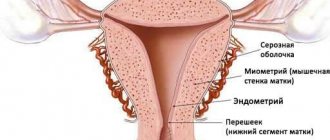Menopause is a period of decline in reproductive function that occurs at a certain age in every woman. It is accompanied by a number of different changes in the body, the main of which are inhibition of the production of female sex hormones in the ovaries and cessation of ovulation.
The menstrual cycle first becomes erratic and unstable, and then menstruation stops altogether. However, bleeding during menopause can still begin, and its causes vary. This should alert the woman: in this case, she needs to urgently contact a gynecologist to find out and eliminate the causes of the malaise. Bloody discharge after menopause is also usually a cause for concern; these cases also require immediate consultation with a gynecologist.
Causes of bleeding during menopause
A woman's body is a complex system.
During his life, he experiences serious transformations, characterized by changes in hormones: the first menstruation, pregnancy and menopause after 40 years. The number of eggs ripe for fertilization and the hormones required for the normal functioning of the reproductive system decreases with the onset of menopause. Postmenopause is the last stage in the transformation of reproductive function. This is the final cessation of menstruation, which signals the impossibility of conception and development of pregnancy. But during this period, pathological bleeding may occur during menopause, forcing women to see a doctor, adhere to his prescriptions and undergo long-term treatment.
Is bloody secretion normal?
Bleeding in postmenopause requires careful examination and assistance from a doctor. Significant disruptions in the functioning of the female organs that are identified in time can be treated and go away completely. Discharge with blood during this age period indicates the presence of a serious disease that forms in the endometrium of the uterus. This may indicate the development of a tumor.
Menstruation stops because this period marks the end of female reproduction. Lack of menstruation, thinning of the mucous layer of the uterus, reduction in the size of the ovaries, absence of follicles - conditions are created in the body that are unfavorable for conception.
Problems with women's health at this age are not uncommon. They force the woman to seek medical help. The most common causes of bloody discharge can be caused by:
- taking hormonal drugs;
- infections;
- chronic female diseases;
- injury to the mucous walls;
- maturation of the polyp;
- thickening of the endometrium;
- fibroids;
- cancerous tumors.
Being in reproductive age, bleeding is considered a normal process for a woman and occurs during menstruation. Natural withdrawal of the endometrial layer occurs in the case when there was no conception. The body spontaneously gets rid of excess cells. When the endometrium is rejected, as a result of vascular injury, bloody uterine discharge occurs.
During menopause, the endometrial layer does not grow and is not excreted. Mucus discharge at this age becomes infrequent, and vaginal dryness is observed. Due to changes occurring in the body, blood loss is excluded. This applies not only to heavy discharge, in the form of the usual menstruation, but also to mucus streaked with blood. In postmenopausal women, such indicators are not normal and require serious examination.
How to stop bleeding at home
Uterine bleeding during menopause is especially dangerous, since irregular menstruation and varying volumes of discharge can mislead a woman. You can stop bleeding with medications (tablets, injections of hemostatic drugs), and at the same time, in consultation with your doctor, use traditional medicine methods.
Bleeding after menopause most likely means the presence of serious cancer in the body. It is strictly forbidden to treat yourself at home; an urgent examination in a hospital is required, as urgent surgery may be required.
Pills
Typically, hemostatic medications are used to stop minor bleeding:
- calcium gluconate – reduces capillary permeability;
- Vikasol (an artificial analogue of vitamin K) – stimulates the production of prothrombin and proconvertin;
- Dicinone - reduces the permeability of vascular walls and stimulates the formation of thromboplastin;
- aminocaproic acid – inhibits fibrinolysis.
If the cause is established, and uterine bleeding occurs regularly, then the treating gynecologist prescribes pills in combination with traditional medicine methods. Also, such drugs are prescribed for heavy periods that cause blood loss.
Herbs
Doctors recommend using hemostatic herbs for uterine bleeding during menopause. These include the following medicinal plants:
- stinging nettle : place crushed dry raw materials in the amount of 4 tablespoons in boiling water (0.25 l) and cook over low heat for 0 minutes. Cool, strain and drink one tablespoon 5 times a day;
- shepherd's purse : pour dried raw materials (a tablespoon) with boiling water (0.25 l) and prepare an infusion, leaving for 1 hour. Strain and drink one tablespoon 4 times a day before meals;
- viburnum : mix fresh berries with sugar (to taste), grind. Add boiled water, maintaining a 1:1 ratio. Drink a tablespoon 3 times a day;
- yarrow: brew 2 teaspoons of raw material in boiling water (0.25 l), leave. After an hour, strain and drink a quarter glass of infusion 4 times a day.
Menstruation during menopause (usually aged 45 years and older) should be under the constant supervision of a woman. A change in the nature of the discharge and its frequency may indicate the onset of a disease that needs to be promptly identified and treated.
Spotting in postmenopause warns of the need to undergo examination for cancer, and the occurrence of bleeding after the menopausal period may require urgent surgery. Paying attention to your health during menopause can prevent unwanted health consequences.
Why does bloody discharge occur?
The causes of bleeding during menopause can be different. You can see them on underwear, napkins or sanitary pads. If a woman experiences this, then it is necessary to make sure that their source is located in the vagina, since the cause of the appearance of blood may be damage to the urethra or rectum. To preventively determine the site of bleeding, you will need a hygienic tampon. It must be inserted into the vagina (as during menstruation). If there are no traces of blood on it, then it is not uterine discharge. If the tampon contains blood clots, you will need to contact a gynecologist. This symbolizes serious problems in the uterus or its cervix. Bloody discharge during menopause is a symptom of the following diseases:
- vaginitis, vulvovaginitis and various inflammations (gonorrhea, chlamydia, trichomoniasis);
- endometrial and cervical canal polyps;
- uterine fibroids;
- cancer of the uterus or cervix;
- cancer of the uterine walls.
Menopause is characterized by a gradual cessation of production of female hormones in the body. This causes not only general changes in the body, but also transformations in the mucous layer. The lining of the uterus thins and becomes vulnerable, and partial atrophy occurs. Each increased contact with the walls can lead to damage and will be accompanied by sanguineous discharge. Bleeding may be profuse or scanty. They are caused by sexual intercourse, cycling or other physical pressure on the abdominal or groin area.
Vaginitis, vulvovaginitis
Diseases are the result of reduced immunity or abuse of antibiotics. Vaginitis occurs due to infections and viruses, as a result of diabetes or obesity, as well as hormonal imbalances and disturbances in the vaginal microflora. Cases cannot be excluded when, during active sexual intercourse or a poor-quality examination by a gynecologist, third-party intervention occurs and the mucous membrane of the organs is damaged. This may be the cause of vaginitis. The woman experiences discomfort in the vagina, drops of blood appear on her underwear, and sexual intercourse is accompanied by painful sensations. In some cases, dryness and an unpleasant odor may occur.
Polyps
Polypous formations become a source of bloody discharge. A polyp is a local growth in the area of the integumentary (external) tissue. The deviation may appear as a result of hormonal imbalance or occur due to inflammation. A polyp is a benign neoplasm. It develops as a result of chronic diseases of the uterus, physical damage to the mucous membrane. There is no pain with polyps, but they are identified by a gynecologist during a medical examination. Their presence may be indicated by heavy bleeding during menopause, during sexual intercourse, as well as before and after the end of menstruation. They require early diagnosis and removal to prevent their transformation into malignant nodes.
Uterine fibroids
This type of benign growth develops in muscle tissue. According to statistics, it forms in women at the initial stage of menopause and menopause. In the process, blood flow to the female organs is limited and the fibroid stops growing, disappears completely, without causing any problems for the woman. When diagnosed, profuse bleeding is visible in cases where treatment with hormones and estrogenic herbal preparations is used.
Changes in the vagina associated with age
In the body of a woman at the age when menopause occurs, the production of sex hormones no longer occurs. So the body no longer produces estradiol, estriol, estrone, resulting in a process of thinning of the epithelium. This process of thinning of the mucous membrane occurs due to a change in the qualitative composition of the cervical mucus.
This mainly affects the changes in the vaginal mucosa and it becomes thinner. The vaginal mucosa becomes so thin that even the most minor damage causes bleeding, more or less profuse. Typically, discharge may begin during or after sexual intercourse. In addition, discharge can be triggered by masturbation or begin after cycling or horseback riding, as well as after doing gymnastics, etc.
Treatment for the appearance of symptoms such as bleeding from the vagina during menopause is as follows: if a woman has an active sex life, and discharge appears during or after sexual intercourse, then she should start using lubricants that are sold in any pharmacy. If a woman experiences vaginal dryness, a specialist will prescribe vaginal suppositories containing estrogen. Thanks to estrogen, the functioning of the vaginal mucosa will return to normal. If, in addition to dryness, a woman exhibits other signs of menopause, the specialist will prescribe hormonal treatment.
Source: womanchoise.ru
Similar articles
- The discharge is white, bloody, brown when taking hormonal OCs. A number of contraceptive drugs are used not only to prevent unwanted pregnancy, but also to correct hormonal parameters in the event of the development of certain gynecological pathologies, for example, cystic ovarian tumors or endometriosis. Their character can...
- Why is there white and thick discharge after ovulation, reasons? The ovulation period is the time when a mature egg is released from the follicle in one of the female ovaries, ready for the fertilization process. During the process of the release of the egg and its movement through the fallopian tube into the cavity...
- Transparent, odorless discharge in women: causes, whether it is necessary to treat Transparent, odorless discharge is not considered dangerous: it is an excess of mucous secretion secreted by the glands located at the entrance to the vagina. Its purpose is to maintain an appropriate level of moisture in the vagina, fluctuations of which can...
What to do
If bloody discharge is detected during menopause, it is necessary to establish the origin and location of the focus that led to the blood flow, and to find the cause of such unfavorable symptoms. Timely and high-quality diagnosis of the pathology gives the woman every chance of a full recovery. Gynecologists use curettage in treatment. This method performs research tasks. It is hoped that after the procedure, the disturbing discharge will disappear. The procedure is capable of providing therapeutic therapeutic effects.
Patients over 50 years of age are effectively helped by the use of medications that contain androgens that can inhibit sexual function. To eliminate climacteric syndromes, conventional sedatives are used. Along with the treatment recommended for the underlying disease, the gynecologist also pays attention to techniques aimed at the complete recovery of the female body. To do this, you will need to change your diet - increase the content of vegetables, fruits and fermented milk products, in particular cottage cheese.
To eliminate the negative effects of menopause and avoid the accompanying transformations in bone tissue, you need to use therapeutic exercises, use feasible loads through sports, but first you need to strictly calculate them. Activity and a good mood can prolong youth and go through menopause painlessly.
Bloody discharge during menopause
Many poets and writers call a woman a mystery of nature, but even more mysterious and complex is the female body, which can completely succumb to hormonal changes several times throughout its entire life. During puberty, menstruation begins, in the reproductive state - bearing a child and undergoing childbirth, and in adulthood - the menopause comes. With the onset of menopause, the level of female hormones in the body decreases and the number of eggs produced decreases. The reproductive function of the fair sex ends. For many women entering menopause, symptoms such as hot flashes, emotional surges, pressure changes, decreased body resistance and brittle bones are familiar. More serious manifestations may be bleeding during menopause.
Now we are not talking about spotting during premenopause, because for this time menstruation is still a completely natural process, when the ovaries have not completely stopped producing eggs. But every year the endometrium in the uterus becomes thinner and flatter, ceases to divide into the main and functional layers, the release of sex hormones ceases, and menstruation ends. For spotting during menopause, the cause can be very serious diseases, so at the first smear on your panties you should immediately make an appointment with a gynecologist.
Basically, such symptoms can be eliminated with medication, but they should not be ignored or treated irresponsibly, since sometimes even small discharges can indicate the presence of malignant tumors in the female genital organs.
Why is blood released during menopause?
Bloody or sanguineous discharge on a diary or panties does not always come out of the vagina; their source can be the urethra or anus. During menopause, such situations are common.
To verify the presence of discharge specifically from the genital organs, you need to insert a hygienic tampon into the vagina; if, after removal, there are traces of blood on it, you need to immediately contact a specialist.
Bloody discharge after and during menopause can be symptoms of the following diseases:
- infectious and inflammatory (vaginitis, vulvovaginitis, gonorrhea, chlamydial infection, trichomoniasis);
- abnormal growth of the mucous membranes of the uterus and its cervix;
- fibroids in the uterus;
- cancerous formations on the cervix and in the organ itself;
- oncological formations in the endometrium.
Let's take a closer look at each of the causes of bleeding during menopause.
Inflammation and infectious diseases
During menopause, infectious diseases can appear, regardless of whether a woman is sexually active or not, because during this period, against the background of hormonal changes and atrophied mucous membrane, the composition of the vaginal microflora also changes. As the body’s overall resistance decreases, pathogenic bacteria multiply more actively and invade new territories. The following diseases can cause bleeding during menopause:
- bacterial vaginitis;
- trichomoniasis;
- chlamydial infection;
- gonorrhea.
Diagnostics
If you experience spotting during menopause, the first thing you need to do is contact your gynecologist. After a thorough examination, the doctor may prescribe additional examinations:
- hemostasiogram;
- analysis of hormone concentrations;
- analysis for tumor markers in the blood;
- examination of the cervix and vagina using a microscope;
- hysteroscopy;
- excision of part of the endometrium for further microscopic examination;
- ultrasound diagnostics;
- obtaining a tomographic image using the phenomenon of magnetic resonance.
Postmenopausal bleeding
Any vaginal discharge in a postmenopausal woman over 60 years of age is abnormal and requires determination of the source of the bleeding. About a third of cases are caused by precancerous or malignant lesions of the cervix or endometrium.
The most common malignancies that cause vaginal bleeding are cancers of the vulva, cervix, endometrium, and hormone-secreting ovarian malignancies. Endometrial hyperplasia is more common and increases the likelihood of developing an estrogen-secreting ovarian tumor.
How to treat bleeding?
Treatment of a patient with bleeding during menopause depends on the cause of its occurrence and intensity. If blood is released without stopping and this leads to anemia, then a diagnostic curettage is performed, during which the doctor removes the excess layer of the endometrium, and part of the biomaterial is sent for research, during which the cause of the bleeding is determined. Usually, after curettage, women under 50 can be prescribed corpus luteum hormones, and older women can be prescribed androgens to suppress sexual function.
If the pelvic organs are not affected, then conservative treatment is carried out. The patient is prescribed medications that spasm blood vessels and reduce blood loss; in addition, medications that strengthen the walls of the capillaries may be prescribed.
Malignant formations in the uterus and appendages are a direct indication for surgical intervention. During menopause, doctors usually do not try to perform organ-preserving operations to prevent relapse of the disease. Most often, during menopause, the uterus or uterus along with the appendages will be removed.
The question of norm and pathology
To understand whether bleeding during menopause is normal or pathological, you need to have at least a general understanding of the processes that occur during menopause.
Menopause doesn't happen overnight. The first signals of the oncoming menopause may appear several years before it actually occurs. An irregular menstrual cycle, a change in the nature of menstruation (their abundance changes in one direction or another) - these are the precursors of menopause. Then menstruation comes less and less often until it stops altogether. While the work of the ovaries has not completely subsided, this may manifest itself in the fact that instead of the usual menstruation, minor impurities of blood appear. This is the period of perimenopause. In this case, this is the norm.
If a woman has already entered menopause, and has not had menstruation for 1 year, and after that discharge suddenly appears, this is a reason to consult a doctor, since it is outside the normal range.
What to do if bleeding starts after menopause: causes and treatment methods
Postmenopause is the final stage of menopause. During this period, the reverse development of the woman’s reproductive system is completed, the ovaries no longer produce eggs, and the woman completely loses the ability to conceive.
Since the hormone estrogen is no longer synthesized, the amount of discharge is reduced to a minimum. Therefore, spotting after menopause is always a cause for concern , as it indicates serious problems in a woman’s body.
Signs of pathology
At the late stage of menopause, when the regulator has been gone for more than a year, it is impossible not to notice this phenomenon. The appearance of any number of blood clots on underwear during this period requires consultation with a specialist.
Many women with hemorrhage from the uterus note a general deterioration in their health. The pathology may be accompanied by nagging pain in the lower abdomen, dizziness, a feeling of fullness in the stomach, and pain when going to the toilet. However, blood loss can occur without accompanying symptoms; this condition is the most dangerous, because without feeling pain, the woman does not rush to the gynecologist, and the disease continues to develop.
If there is excessive hemorrhage, you need to call an ambulance. You should call the emergency room if blood from the uterus during menopause is accompanied by:
- Sharp pain in the lower abdomen;
- Increase in temperature;
- Dizziness;
- General weakness;
- Nausea or vomiting;
- Pale skin;
- Fever.
If the discharge looks like menstruation, and a year has not yet passed since the last critical days, most likely the functions of the ovaries have not yet completely died out. If discharge with clots appears in the late menopausal stage, this is an alarming sign. Most likely, clots indicate intrauterine plasma coagulation. This phenomenon occurs when plasma accumulates in the uterine cavity.
How a woman's body changes during menopause
Menopause is the natural end of the childbearing period. Under the influence of hormonal changes, all reproductive organs change.
The change takes place in several stages:
- gradual cessation of ovarian function . At first there are still eggs in them, but very few. Then the ovarian tissue is replaced by connective tissue, the organs dry out;
- reduction in the size of the uterus, thinning of the endometrium . Then the uterine tissue also changes to connective tissue, that is, the contractile function of the organ is lost. At the last stage, the uterus is completely overgrown;
- reduction in the length of the cervix and cessation of mucus secretion;
- thinning of the vaginal walls , decreasing its elasticity. As a result, the vessels located near the vaginal mucosa also become thinner and can be easily injured. This becomes a common cause of blood droplets;
- involution of the mammary glands , replacement of glandular tissue with adipose tissue.
Types of discharge after menopause
Many women wonder: what kind of discharge after menopause can be considered normal? Doctors give a clear answer to this question: the norm is considered to be a cream-colored, odorless mucous discharge that does not cause a woman any unpleasant sensations (itching, burning). Their volume should not exceed 1.5 ml per day.
The decline of reproductive functions does not occur in one day. Therefore, menstruation stops gradually. At first they become rare, then the volume of blood released decreases. Therefore, bleeding, which is menstruation, is considered normal during menopause. But during the postmenopausal period they should not be.
In addition to normal discharge, a woman may experience other, pathological discharge.
They can be:
- white curds with a sour odor;
- greenish with the smell of rotten fish;
- yellow with an unpleasant odor;
- copious watery;
- bloody, ranging in color from bright red to brown. It can also be in the form of bleeding or spotting.
All these types of discharge are classified as pathological, requiring examination and treatment.
Vaginal cancer. Bleeding during menopause and cancer
Vaginal cancer is a fairly rare disease. The main factor influencing its occurrence is the woman’s age. A large number of women diagnosed with vaginal cancer are already 60 years of age or older.
The early stages of vaginal cancer are characterized by an asymptomatic course of the disease, but the more the cancer progresses, the sooner the woman begins to bleed. In addition, a woman may experience colorless, watery discharge or a feeling of uterine distension; the process of urination or defecation may also be accompanied by pain.
A specialist can easily detect vaginal cancer during a routine examination. In order to confirm the diagnosis of vaginal cancer, a specialist must perform a colposcopy and biopsy. The collected material is subjected to histological analysis, which confirms or excludes the presence of cancer cells in the vagina.
Therapy depends entirely on what type of cancer it is, what its stage of development is, what the woman’s age is and other factors. Generally, surgery, chemotherapy and radiotherapy are used as treatment.
Bloody discharge and its causes
The appearance of blood streaks in the discharge is always alarming. This may indicate a serious pathology in the body, including cancer. There are several other provoking factors that can cause bleeding from the vagina, for example, trauma to the mucous membrane. In addition, blood discharge can be not only from the vagina, but also from the urethra or intestines.
The main causes of bleeding after menopause are:
- long-term use of hormonal drugs . To reduce the negative manifestations of menopause, women are prescribed hormone replacement therapy. If the dosage is incorrectly selected, the functions of the ovaries are enhanced, which leads to the growth of the endometrium. Therefore, the uterine mucosa begins to bleed;
- oxidation of cervical mucus . The cervical canal is tightly closed, so the mucus does not come out in time. This is manifested by brownish discharge;
- mucosal injuries . The thinning of blood vessels makes the walls very vulnerable to the slightest physical impact. Therefore, blood may be released after a gynecological examination, sex, sports, or after performing hygiene procedures;
- cervical erosion . Its danger lies in the high risk of degeneration into cancer;
- infections . Hormonal changes lead to decreased immunity. During this period, pathogenic bacteria begin to multiply intensively, even if the woman is not sexually active. Bloody discharge may be a sign of chlamydia, gonorrhea, or trichomoniasis. In this case, the discharge is accompanied by a burning sensation, an unpleasant odor, and sometimes an increase in temperature;
- endometrial polyp . Sometimes the uterine mucosa does not thin out, but grows into several layers, which leads to the formation of polyps. In postmenopause, polyps are dangerous due to their degeneration into a malignant tumor, so they need to be treated urgently;
- endometrial hyperplasia , that is, its pathological growth. Usually, during menopause, this disease disappears, but in some cases, hormonal changes, on the contrary, can provoke its growth. A distinctive sign of the disease is cramping pain accompanying bleeding;
- uterine fibroids. This type of tumor also decreases during menopause. But taking hormones does not allow fibroids to “disappear.” Discharge from fibroids can be of varying intensity - from spotting to heavy;
- cancer of the cervix or uterine body . Bloody discharge is preceded by watery discharge, which the woman does not pay attention to. The discharge is not accompanied by pain, this should alert you. At the first symptoms, you should urgently consult a specialist;
- ovarian tumors . In postmenopause, the ovaries no longer function. But, thanks to the same hormonal agents, tumors that produce hormones appear on them. At the same time, the woman’s appearance improves, she seems to be younger. Bloody discharge similar to menstruation also resumes. All this should alert you and be a reason to consult a doctor.
First aid at home
It is important to understand that the occurrence of heavy uterine bleeding during menopause should force every woman to urgently consult a doctor for advice. This is how a woman gets the opportunity to avoid the most serious complications - severe anemia, an emergency state of hemorrhagic shock, etc.
However, if the bleeding is not too heavy at first, you can try to provide first aid yourself (although after this it is still very important to consult a doctor). Adequate emergency care for such patients may include:
- using a cool compress on the lower abdomen;
- in taking a lying position and resting.
Unfortunately, there are no other home measures or remedies to help patients with vaginal bleeding.
Should I go to the doctor?
Any unusual discharge is a reason to consult a doctor. You need to go as soon as they appear, so that the doctor can reliably determine the cause. Most cancers can be cured only at an early stage.
The specialist prescribes a number of diagnostic tests:
- blood test for hormones;
- blood for tumor markers;
- Ultrasound of the pelvic organs;
- Flora smear;
- colposcopy;
- MRI.
All these methods will help confirm or refute the presence of severe pathology and prescribe appropriate treatment in a timely manner.
Examination techniques
Before starting any treatment (using folk remedies or medications) for uterine bleeding in an older woman, doctors always conduct a full diagnosis of the problem.
To determine the nature of vaginal discharge, women undergo a whole range of clinical and laboratory examinations, including:
- standard gynecological examination, history taking, which determines the amount of blood loss;
- laboratory determination of the level of a hormone such as β-hCG (to exclude pregnancy);
- conducting clinical, biochemical blood tests with studies of the blood coagulation system;
- Specific hormonal studies may also be required (showing the level of estradiol, progesterone, LH, FSH, thyroid hormones);
- performing transvaginal ultrasound or colposcopy;
- sonohysterography, MRI, biopsy and many other studies.
Modern research methods make it possible to quickly determine the causes of a problem. But it is the correct identification of the causes that is the key to the correct selection of further treatment using certain medications.
Treatment methods
The choice of treatment method depends on the underlying cause. If the cause of bleeding is the use of hormones, a dose adjustment or complete discontinuation of the drug will be required. To strengthen the walls of blood vessels, medications are prescribed that reduce capillary fragility and promote vasoconstriction.
In some cases, diagnostic curettage of the uterus will be necessary. This method helps get rid of bleeding. Part of the biological material is sent for histology to diagnose a cancerous tumor.
For polyps and fibroids, the doctor prescribes hormonal treatment or surgery. This depends on the size of the tumor and the condition of the patient. Cancerous tumors require removal, and all reproductive organs are removed. Only in this case can a complete cure be achieved and relapse prevented.
Uterine cancer (endometrial cancer)
The endometrium is the lining of the uterus and that is why, in some cases, endometrial cancer is called uterine cancer.
The main sign of uterine cancer is spotting or uterine bleeding. A woman who has reached menopause should not be negligent about bleeding. At the first signs, you should seek advice from a specialist. The earlier uterine cancer is detected, the easier it is to treat it without having to remove the uterus.
In order to diagnose uterine cancer, a woman should undergo an ultrasound examination, hysteroscory, endometrial biopsy and other methods.
Treatment for uterine cancer is based on the type of cancer and its stage, the woman’s age and other factors. The main methods of treatment for uterine cancer are chemotherapy and radiotherapy, as well as surgery.











